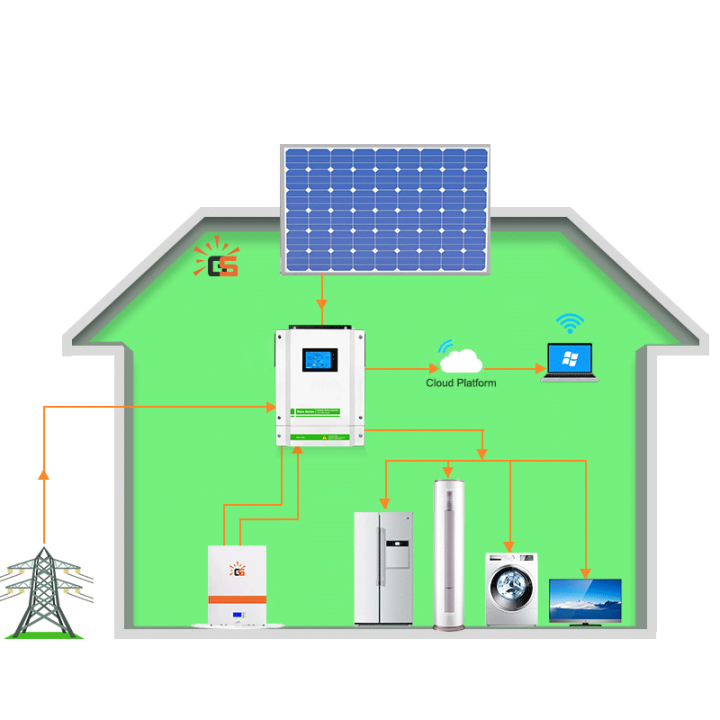GSOK POWER LTD.

Since 2022, the global demand for household energy storage batteries has gradually become hot. As a new market, both the products and the market are still in the exploration stage. At the same time, considering the high cost of household energy storage batteries, how to use the home storage system more efficiently and economically is very important, GSOK POWER LTD. Based on many years of experience, the configuration design and requirements of household energy storage battery system are analyzed and summarized from different dimensions.
Structure of solar household energy storage battery system

The above figure is a typical household energy storage battery system, which is mainly composed of solar panels, power grids, inverters, batteries and electrical equipment. The input only solar panels is called off-grid system, while the input of solar panels and the municipal grid is called mixed grid system. If only the input of municipal power, it is generally used as a backup power system
2. User demand analysis
2.1 First of all, it is necessary to understand the types of electrical equipment and equipment power of the user.
First make a list of the user's electrical equipment, fill in the maximum power, and then calculate the total power P0.
P0 = (P1 + P2, P3 +... +Pn
2.2 Understand the number of electrical equipment that may be used at the same time and calculate the total power value P1. The purpose of this step is to prepare for the subsequent more reasonable configuration of the inverter.
3. inverter selection
3.1 Power Selection
According to the analysis result of user demand, choose the inverter with rated power higher than P0, if the customer budget is insufficient, the requirements can be reduced, choose rated power > P1 Inverter. The maximum output power of the inverter determines the maximum power of the equipment that the user can use at the same time, so this choice is very key. If the configuration is small, in actual use, there will be overload, light will lead to overload protection, heavy will burn the inverter.
4.household energy storage battery energy configuration
4.1 Battery System
Lithium iron phosphate battery: a single voltage of 3.2V, can be combined through series and parallel into the required voltage and capacity, currently 24V and 48V, need to be strictly managed by BMS. Advantages are safety, long life, disadvantage is compared with three yuan, large volume, weight
4.2 Household energy storage battery voltage matching
Household energy storage battery voltage is mainly determined by the inverter, and needs to match the input voltage of the inverter, such as 48V inverter with 48V battery, 96V inverter with 96V battery, can not be mismatched.
4.3 Household energy storage battery energy configuration
This is determined by the user's budget, depending on how long the user wants the full power to be used. For example, the total power of the user's equipment is P, the use time of the full power is h, the conversion efficiency of the inverter is β, then the battery energy Q=P*h/β.
4.4 Output Power
Generally, it is determined by the design of the household energy storage battery system, the discharge rate of the receiving cell, the maximum current that the system structure can withstand, the maximum current of BMS, and the heat dissipation performance. For example, for a 48V system, the designed maximum output current is 100A, the output power is 4800W.
4.5 Function Requirements
This refers to some additional functions in addition to electrical performance, such as display function, mobile APP monitoring function, remote control function, etc., which are selected according to user needs.
5. photovoltaic module configuration
5.1 Maximum Allowable Installation Power
This value is determined by the amount of open space a user can use to install the panels, usually the roof, which limits the maximum amount of total solar power allowed to be installed. If the available area is S square, the area of each solar panel is S1, and the power is Pw, the maximum solar panel power P=S/SI*Pw can be installed.
5.2 Actual solar panel power
This value is determined by the user at the beginning of the system design, if the user needs to fill the battery time is T, assuming that the local effective light time is t, then the solar panel power P= battery energy /T/t=Q/T/t. P must be less than or equal to the maximum allowable installed power Pw. This value is affected by the budget. If the budget is sufficient, then P is equal to Pw
6. Other accessories
6.1 Installing Supports
Mainly refers to the solar panel installation bracket, which depends on the number of solar panels and installation method.
6.2 Wire
The various connection wires shall be determined during the system design